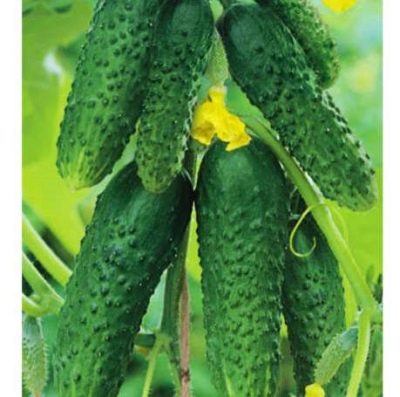
- Authors: Gavrish S.F., Shevkunov V.N., Khomchenko N.N., Pluzhnik I.S., Tishchenko L.A.
- Year of approval: 2019
- Growth type: indeterminate
- Branching: the average
- Fruit weight, g: 90-120
- Fruit length, cm: 10-13
- Fruit color: green with small light stripes
- Cucumber Mosaic Virus Resistance: stable
- Ripening terms: early
- Pollination: bee-pollinated
Early cucumbers are especially prized in areas of so-called risky farming. The Siberian Express hybrid, unpretentious to care for, in a short summer begins to bear fruit so rapidly that its harvest does not catch the autumn cold, and grateful summer residents have time to collect it.
Breeding history
Siberian Express F1 was bred by domestic breeders from the breeding company "Gavrish". A group of specialists consisting of S. Gavrish, V. Shevkunov, N. Khomchenko, I. Pluzhnik and L. Tishchenko received a new hybrid of the first generation not so long ago, in 2017, and already 2 years later, in 2019, after the conducted variety trials the crop received a registration in the Register of Breeding Achievements of the Russian Federation and was recommended for growing both in the open field and under film, in the gardens of personal subsidiary farms.
Description of the variety
Today the Siberian Express is one of the most unpretentious and productive cucumbers bred in recent years. Working on the creation of a hybrid, breeders tried to do everything to make caring for the crop easy and enjoyable.
Characteristics of the appearance of plants and zelents
The plant of the considered hybrid variety is distinguished by an indeterminate type of growth. The bushes have medium branching. A bee-pollinated hybrid with female flowers forms up to 11 ovaries in each bunch. Leaves are green in color, medium in size.
Zelenets is short, 10-13 centimeters, cylindrical in shape, green in color, there are small light stripes on the skin, medium tubercles, white thorns. By weight, zelents grow on average 90-120 grams.
Purpose and taste of fruits
The pulp of the Siberian Express fruit is juicy, sweetish, with a crunch. The taste is generally pleasant, with a cucumber aroma. Zelentsy have a universal purpose, are suitable for canning, are good in pickles, salted, also tasty in summer salads, sliced. Stored after removal from the bush for 8 to 12 days, without losing their presentation and taste.
Maturation
An early ripening culture from domestic breeders is capable of bearing ripe fruits 41-46 days after germination.
Yield
The average marketable yield of the Siberian Express is at the level of 12.6-14.9 kg / sq. m. From one bush, you can remove up to 8 kg of greens.
Growing regions
Rosreestr recommended the cultivation of cucumber varieties throughout Russia. However, given the purposefulness of the work of breeders, the crop is especially well suited for cultivation under film in areas of risky agriculture with short summers, where the heat can be abruptly replaced by prolonged coolness.
Growing and care
The originators recommend growing the Northern Express hybrid in greenhouses. But many farmers note the good productivity of cucumber when cultivated in tunnels, in open beds. Sowing dates depend on the climate of the area, weather, the future place of cultivation.
Seedlings at planting should be 26 days old, have 2-4 leaves on the sprouts, as well as a formed root system.The culture does not tolerate various transplants, therefore, seeds are sown in separate containers, after which the grown seedlings are transferred to a permanent place in prepared holes.
Before planting, the seedlings are gradually hardened for 8-10 days, for this they are taken out into the air (balcony, veranda). This is necessary so that the seedlings adapt faster and better in greenhouses and do not get sick.
There are no special differences in the agricultural technology of cucumbers cultivated in the greenhouse and in the ground. True, in closed beds, the first harvest of fruits is still faster. In any case, fertile soil types with neutral pH should be used. If deoxidation is necessary, lime or chalk must be added. High yields are obtained by gardeners who observe crop rotation on the site.
To cultivate the Siberian Express in shelters, it is necessary to install trellises: first, the supports are fixed, the wire is pulled over them - it does not sag, unlike the rope.
The originators recommend the following planting scheme in a greenhouse: 2-3 bushes per 1 m². On open ground, plants are grown in a spread pattern - 3-4 plants per 1 m².
Caring for the Siberian Express includes activities such as loosening between rows, irrigation, feeding, bush formation, prevention of diseases, harmful insect attacks.

In order to collect strong, tasty and beautiful cucumbers on your site, you need to make top dressing. Lack of nutrients can negatively affect the appearance of the plant and significantly reduce the yield. Fertilize cucumbers with organic fertilizers in combination with mineral fertilizers. With the right balance of these components and adherence to the fertilizing schedule, the cucumber yield will be maximum.

Despite their popularity, cucumbers are often attacked by diseases and pests. From them, cucumber plantings often die before the start of fruiting. In order to prevent this from happening, it is necessary to try to prevent ailments or get rid of them at the very beginning, having studied in detail their causes of occurrence, signs and methods of treatment.





























































































